The Role of High Nature Value Farmland for Landscape and Soil Pollution Assessment in a Coastal Delta in China Based on High-Resolution Indicators
Abstract
:1. Introduction
- (a)
- High-resolution (2 m × 2 m) indicators (i.e., LC, NDVI, SH, and SI) are applied for first time to develop a potential HNVf map based on a coastal delta in China;
- (b)
- The role of the HNVf map in landscape and soil pollution assessment is analyzed.
2. Materials and Methods
2.1. Study Area
2.2. Indicators and Auxiliary Data
2.2.1. Land Cover Indicator
| Study Area | Resolution | Land Cover Types | HNVf Identification Result | Reference |
|---|---|---|---|---|
| Ireland | 2 km × 2 km | Beach, water, pasture, arable land, and shrubs | It represents the most comprehensive method to identify the HNVf | [29] |
| Estonia | 1 km × 1 km | Inland plots, coastline intersection or contact plots, and urban areas | Better recognition in coastal areas, flood plain valleys, and moraine land | [21] |
| Wales | 1 km × 1 km | Semi-natural land | At low-intensity land use, species-rich groups include wetland plants, plant habitat indicators, upland birds, and so on | [30] |
| France | 250 m × 250 m | Semi-natural elements, urban and agricultural areas | All indicators can relate to the dimensions of land use intensity | [31] |
| Italy | 100 m × 100 m | Farmland, non-irrigation arable crops | Better recognition of HNVf type 3 | [32] |
| Italy | 50 m × 50 m | Urban fabric, arable lands, permanent crops, pastures, and heterogeneous agricultural areas | Compared to traditional land cover map, agricultural statistics improved the identification results of HNVf | [17] |
| United Kingdom | 30 m × 30 m | The UK Biodiversity Action Plan Broad Habitats | Land cover type have been the main data used for reporting but no consistent set of data metrics have been agreed | [23] |
2.2.2. Vegetation Indicator
2.2.3. Richness Indicator
2.2.4. Soil Sampling Data
2.2.5. Migration Distance and Landscape Index
2.3. Weight and Verification
3. Results
3.1. Land Cover across YRD
3.2. High Nature Value Farmlands across the YRD
3.3. Validation of the HNVf Map
4. Discussion
4.1. Indicator Characteristics and Development Potential of HNVf
4.2. Effect of Spatiotemporal Evolution of Intensive Farmland on HNV
4.3. Characterization of Soil Heavy Metals in the HNVf and Non-HNVf
5. Conclusions
Author Contributions
Funding
Institutional Review Board Statement
Informed Consent Statement
Data Availability Statement
Conflicts of Interest
References
- Wade, M.R.; Gurr, G.M.; Wratten, S.D. Ecological restoration of farmland: Progress and prospects. Phil. Trans. R. Soc. B Biol. Sci. 2008, 363, 831–847. [Google Scholar] [CrossRef] [PubMed]
- Flandroy, L.; Poutahidis, T.; Berg, G.; Clarke, G.; Dao, M.; Decaestecker, E.; Furman, E.; Haahtela, T.; Massart, S.; Plovier, H. The impact of human activities and lifestyles on the interlinked microbiota and health of humans and of ecosystems. Sci. Total Environ. 2018, 627, 1018–1038. [Google Scholar] [CrossRef] [PubMed]
- Xu, D.; Li, D. Variation of wind erosion and its response to ecological programs in northern china in the period 1981–2015. Land Use Policy 2020, 99, 104871. [Google Scholar] [CrossRef]
- Wang, H.; Zhang, C.; Yao, X.; Yun, W.; Ma, J.; Gao, L.; Li, P. Scenario simulation of the tradeoff between ecological land and farmland in black soil region of northeast china. Land Use Policy 2022, 114, 105991. [Google Scholar] [CrossRef]
- Penghui, J.; Manchun, L.; Liang, C. Dynamic response of agricultural productivity to landscape structure changes and its policy implications of Chinese farmland conservation. Resour. Conserv. Recy. 2022, 156, 104724. [Google Scholar] [CrossRef]
- Ma, L.; Long, H.; Tu, S.; Zhang, Y.; Zheng, Y. Farmland transition in China and its policy implications. Land Use Policy 2020, 92, 104470. [Google Scholar] [CrossRef]
- Liu, M.; Jia, Y.; Cui, Z.; Lu, Z.; Zhang, W.; Liu, K.; Shuai, L.; Shi, L.; Ke, R.; Lou, Y. Occurrence and potential sources of polyhalogenated carbazoles in farmland soils from the three northeast provinces, china. Sci. Total Environ. 2021, 799, 149459. [Google Scholar] [CrossRef]
- Zhang, Q.; Wang, Y.; Jiang, X.; Xu, H.; Luo, Y.; Long, T.; Li, J.; Xing, L. Spatial occurrence and composition profile of organophosphate esters (opes) in farmland soils from different regions of china: Implications for human exposure. Environ. Pollut. 2021, 276, 116729. [Google Scholar] [CrossRef]
- Hu, J.; He, D.; Zhang, X.; Li, X.; Chen, Y.; Wei, G. National-scale distribution of micro(meso)plastics in farmland soils across china: Implications for environmental impacts. J. Hazard. Mater. 2022, 424, 127283. [Google Scholar] [CrossRef]
- Barnes, A.P.; Thomson, S.G. Measuring progress towards sustainable intensification: How far can secondary data go? Ecol. Ind. 2014, 36, 213–220. [Google Scholar] [CrossRef]
- EC-European Commission. Report from the Commission to the European Parliament and the Council the Mid-Term Review of the EU Biodiversity Strategy to 2020; EC-European Commission: Brussels, Belgium, 2015. [Google Scholar]
- Clark, J.; Beaufoy, G.; Baldock, D. The Nature of Farming: Low Intensity Farming Systems in Nine European Countries; Institute for European Environmental Policy: Brussels, Belgium, 1994. [Google Scholar]
- Andersen, E.; Baldock, D.; Brouwer, F.M.; Elbersen, B.S.; Godeschalk, F.E.; Nieuwenhuizen, W.; van Eupen, M.; Hennekens, S.M.; Zervas, G. Developing a High Nature Value Farming Area Indicator; Internal Report for the European Environment Agency; Institute for European Environmental Policy: Brussels, Belgium, 2004. [Google Scholar]
- IEEP. Guidance Document to the Member States on the Application of the High Nature Value Indicator; IEEP: Brussels, Belgium, 2007. [Google Scholar]
- Paracchini, M.L.; Petersen, J.; Hoogeveen, Y.; Bamps, C.; Burfield, I.; van Swaay, C. High Nature Value Farmland in Europe. An Estimate of the Distribution Patterns on the Basis of Land Cover and Biodiversity Data; European Commission: Brussels, Belgium, 2008; p. 23480. [Google Scholar]
- Keenleyside, C.; Beaufoy, G.; Tucker, G.; Jones, G. High nature value farming throughout eu-27 and its financial support under the cap. Inst. Eur. Environ. Policy 2014, 10, 91086. [Google Scholar]
- Bonato, M.; Cian, F.; Giupponi, C. Combining LULC data and agricultural statistics for a better identification and mapping of high nature value farmland: A case study in the Veneto plain, Italy. Land Use Policy 2019, 83, 488–504. [Google Scholar] [CrossRef]
- Pointereau, P.; Paracchini, M.L.; Terres, J.M.; Jiguet, F.; Bas, Y.; Biala, K. Identification of High Nature Value Farmland in France through Statistical Information and Farm Practice Surveys; European Commission Joint Research Centre: Brussels, Belgium, 2007. [Google Scholar]
- Sagris, V.; Kikas, T.; Angileri, V. Registration of land for the common agricultural policy management:Potentials for evaluation of environmental policy integration. Int. J. Agric. Resour. Gov. Ecol. 2015, 11, 24. [Google Scholar] [CrossRef]
- Lomba, A.; Strohbach, M.; Jerrentrup, J.S.; Dauber, J.; Klimek, S.; McCracken, D.I. Making the best of both worlds: Can high resolution agricultural administrative data support the assessment of high nature value farmlands across Europe? Ecol. Indic. 2017, 72, 118–130. [Google Scholar] [CrossRef]
- Kikas, T.; Bunce, R.G.H.; Kull, A.; Sepp, K. New high nature value map of Estonian agricultural land: Application of an expert system to integrate biodiversity, landscape and land use management indicators. Ecol. Indic. 2018, 94, 87–98. [Google Scholar] [CrossRef]
- Carvalho-Santos, C.; Jongman, R.H.G.; Alonso, J.M. Fine-scale mapping of High nature value farmlands: Novel approaches to improve the management of rural biodiversity and ecosystem services. In Proceedings of the IUFRO Landscape Ecology Working Group International Conference, Bragança, Portugal, 21–27 September 2010; Volume 143, pp. 140–150. [Google Scholar]
- Maxwell, D.; Robinson, D.A.; Thomas, A.; Jackson, B.; Maskell, L.; Jones, D.L.; Emmett, B.A. Potential contribution of soil diversity and abundance metrics to identifying high nature value farmland (HNV). Geoderma 2017, 305, 417–432. [Google Scholar] [CrossRef]
- Lomba, A.; Guerra, C.A.; Jongman, R.H.G.; Mccracken, D. Mapping and monitoring high nature value farmlands: Challenges in european landscapes. J. Environ. Manag. 2014, 143, 140–150. [Google Scholar] [CrossRef]
- Hou, P.; Jiang, Y.; Yan, L.; Petropoulos, E.; Chen, D. Effect of fertilization on nitrogen losses through surface runoffs in chinese farmlands: A meta-analysis. Sci. Total Environ. 2021, 793, 148554. [Google Scholar] [CrossRef]
- Zhang, X.; Chen, S.; Yang, Y.; Wang, Q.; Wu, Y.; Zhou, Z.; Wang, H.; Wang, W. Shelterbelt farmland-afforestation induced SOC accrual with higher temperature stability: Cross-sites 1 m soil profiles analysis in NE China. Sci. Total Environ. 2021, 814, 151942. [Google Scholar] [CrossRef]
- He, K.; Sun, Z.; Hu, Y.; Zeng, X.; Yu, Z.; Cheng, H. Comparison of soil heavy metal pollution caused by e-waste recycling activities and traditional industrial operations. Environ. Sci. Pollut. Res. 2017, 24, 9387–9398. [Google Scholar] [CrossRef]
- Wang, J.; Bretz, M.; Dewan, M.A.A.; Delavar, M.A. Machine learning in modelling land-use and land cover-change (LULCC): Current status, challenges and prospects. Sci. Total Environ. 2022, 822, 153559. [Google Scholar] [CrossRef] [PubMed]
- Matin, S.; Sullivan, C.A.; Finn, J.A.; Green, S.; Meredith, D.; Moran, J. Assessing the distribution and extent of high nature value farmland in the republic of Ireland. Ecol. Indic. 2020, 108, 105700. [Google Scholar] [CrossRef]
- Maskell, L.C.; Botham, M.; Henrys, P.; Jarvis, S.; Maxwell, D.; Robinson, D.A. Exploring relationships between land use intensity, habitat heterogeneity and biodiversity to identify and monitor areas of high nature value farming. Biol. Conserv. 2019, 231, 30–38. [Google Scholar] [CrossRef]
- Lorel, C.; Plutzar, C.; Erb, K.H.; Mouchet, M. Linking the human appropriation of net primary productivity-based indicators, input cost and high nature value to the dimensions of land-use intensity across French agricultural landscapes. Agric. Ecosyst. Environ. 2019, 283, 106565. [Google Scholar] [CrossRef]
- Campedelli, T.; Calvi, G.; Rossi, P.; Trisorio, A.; Florenzano, G.T. The role of biodiversity data in high nature value farmland areas identification process: A case study in mediterranean agrosystems. J. Nat. Conserv. 2018, 46, 66–78. [Google Scholar] [CrossRef]
- Rouse, J.W.; Hass, R.H.; Schell, J.A.; Deering, D.W. Monitoring vegetation systems in the Great Plains with ERTS. In Proceedings of the Third ERTS Symposium, Washington, DC, USA, 10–14 December 1973; NASA SP–351. National Aeronautics and Space Administration: Washington, DC, USA, 1973; pp. 309–371. [Google Scholar]
- Magurran, A.E. Ecological Diversity and Its Measurement; Springer: Dordrecht, The Netherlands, 1988; pp. 61–80. [Google Scholar]
- Papa, G.L.; Palermo, V.; Dazzi, C. Is land-use change a cause of loss of pedodiversity? The case of the mazzarrone study area, sicily. Geomorphology 2011, 135, 332–342. [Google Scholar] [CrossRef]
- Griffith, D.A. Theory of spatial statistics. In Spatial Statistics and Models; Springer: Dordrecht, The Netherlands, 1984; pp. 3–15. [Google Scholar]
- Sun, B.; Zhou, Q. Expressing the spatio-temporal pattern of farmland change in arid lands using landscape metrics. J. Arid. Environ. 2016, 124, 118–127. [Google Scholar] [CrossRef]
- An, Y.; Liu, S.; Sun, Y.; Shi, F.; Zhao, S.; Hansen, J.W. Negative effects of farmland expansion on multi-species landscape connectivity in a tropical region in southwest china. Agric. Syst. 2020, 179, 102766. [Google Scholar] [CrossRef]
- Sullivan, C.A.; Finn, J.A.; Gormally, M.J.; Skeffington, M.S. Field boundary habitats and their contribution to the area of semi-natural habitats on lowland farms in east Galway, western Ireland. R. Ir. Acad. 2013, 113, 187–199. [Google Scholar] [CrossRef]
- Beaufoy, G.; Baldock, D.; Clarke, J. The Nature of Farming e Low Intensity Farming Systems in Nine European Countries; IEEP: London, UK, 1994; p. 68. [Google Scholar]
- Peppiette, Z.E.N. The Challenge of Monitoring Environmental Priorities: The Example of HNV Farmland. In Proceedings of the 122nd EAAE Seminar Evidence-Based Agricultural and Rural Policy Making: Methodological and Empirical Challenges of Policy Evaluation, Ancona, Italy, 17–18 February 2011. [Google Scholar]
- EEA. Updated High Nature Value Farmland in Europe: An Estimate of the Distribution Patterns on the Basis of CORINE Land Cover 2006 and Biodiversity Data; Draft. EEA Tech. Rep. A Basis ETC SIA IP 2011 Task 421 Implement; EEA: Brussels, Belgium, 2012; p. 62. [Google Scholar]
- Galdenzi, D.; Pesaresi, S.; Casavecchia, S.; Zivkovic, L.; Biondi, E. The phytosociological and syndinamical mapping for the identification of High Nature Value Farmland. Plant Sociol. 2012, 49, 59–69. [Google Scholar]
- Acebes, P.; Pereira, D.; Oñate, J.J. Criteria for Identifying HNVF: Experience from a WWF Pilot Project with Special Reference to Dehesas. In Proceedings of the ICAAM International Conference, Montados and Dehesas as High Nature Value Farming Systems: Implications for Classification and Policy Support, Campus da Mitra, Universidade de Évora, Évora, Portugal, 6–8 February 2013. [Google Scholar]
- Gotelli, N.; Colwell, R. Estimating species richness. In Biological Diversity: Frontiers in Measurement and Assessment; Magurran, A.E., McGill, B.J., Eds.; Oxford Univerisity Press: Oxford, UK, 2011; pp. 39–54. [Google Scholar]
- Kiester, A. Species diversity, overview. Encycl. Biodivers. 2013, 6, 706–714. [Google Scholar]
- McBratney, A.; Minasny, B. On measuring pedodiversity. Geoderma 2007, 141, 149–154. [Google Scholar] [CrossRef]
- Sullivan, C.A.; Finn, J.A.; ó Húallacháin, D.; Green, S.; Matin, S.; Meredith, D.; Clifford, B.; Moran, J. The development of a national typology for high nature value farmland in Ireland based on farm-scale characteristics. Land Use Policy 2017, 67, 401–414. [Google Scholar] [CrossRef]
- Hossain, M.S.; Arshad, M.; Qian, L.; Kächele, H.; Khan, I.; Islam, M.D.I.; Mahboob, M.G. Climate change impacts on farmland value in Bangladesh. Ecol. Indic. 2020, 112, 106181. [Google Scholar] [CrossRef]
- Ouyang, W.; Gao, X.; Hao, Z.; Liu, H.; Shi, Y.; Hao, F. Farmland shift due to climate warming and impacts on temporal-spatial distributions of water resources in a middle-high latitude agricultural watershed. J. Hydrol. 2017, 547, 156–167. [Google Scholar] [CrossRef]
- Kour, D.; Rana, K.L.; Yadav, A.N.; Yadav, N.; Saxena, A.K. Microbial biofertilizers: Bioresources and eco-friendly technologies for agricultural and environmental sustainability. Biocatal. Agric. Biotechnol. 2019, 23, 101487. [Google Scholar] [CrossRef]
- Vasa, T.; Pothanamkandathil, C. Recovery of struvite from wastewaters as an eco-friendly fertilizer: Review of the art and perspective for a sustainable agriculture practice in India. Sustain. Energy Technol. 2021, 48, 101573. [Google Scholar] [CrossRef]
- Deng, X.; John, G. Improving eco-efficiency for the sustainable agricultural production: A case study in Shandong, China. Technol. Forecast Soc. 2019, 144, 394–400. [Google Scholar] [CrossRef]
- He, J.; Liu, Y.; Yu, Y.; Tang, W.; Xiang, W.; Liu, D. A counterfactual scenario simulation approach for assessing the impact of farmland preservation policies on urban sprawl and food security in a major grain-producing area of China. Appl. Geogr. 2013, 37, 127–138. [Google Scholar] [CrossRef]
- Chen, W.; Ye, X.; Li, J.; Fan, X.; Liu, Q.; Dong, W. Analyzing requisition–compensation balance of farmland policy in China through telecoupling: A case study in the middle reaches of Yangtze River Urban Agglomerations. Land Use Policy 2019, 83, 134–146. [Google Scholar] [CrossRef]
- Chen, L.; Jiang, P.; Chen, W.; Li, M.; Wang, L.; Gong, Y.; Pian, Y.; Xia, N.; Duan, Y.; Huang, Q. Farmland protection policies and rapid urbanization in China: A case study for Changzhou City. Land Use Policy 2015, 48, 552–566. [Google Scholar]
- Ji, H.; Chen, S.; Pan, S.; Xu, C.; Tian, Y.; Li, P.; Liu, Q.; Chen, L. Fluvial sediment source to sink transfer at the Yellow River Delta: Quantifications, causes, and environmental impacts. J. Hydrol. 2022, 608, 127622. [Google Scholar] [CrossRef]
- Wang, J.H.; Hu, P.; Gong, J.G. Taking the great protection of the Yellow River Estuary as the grasp to promote the construction of ecological civilization in the Yellow River Basin. Yellow River 2019, 41, 7–10. [Google Scholar]
- Li, H.; Fan, Y.; Gong, Z.; Zhou, D. Water accessibility assessment of freshwater wetlands in the Yellow River Delta National Nature Reserve. China Ecohydrol. Hydrobiol. 2020, 20, 21–30. [Google Scholar] [CrossRef]
- Zhang, X.; Wang, G.; Xue, B.; Zhang, M.; Tan, Z. Dynamic landscapes and the driving forces in the yellow river delta wetland region in the past four decades. Sci. Total Environ. 2021, 787, 147644. [Google Scholar] [CrossRef]
- Wang, Z.; Xiao, J.; Wang, L.; Liang, T.; Rinklebe, J. Elucidating the differentiation of soil heavy metals under different land uses with geographically weighted regression and self-organizing map. Environ. Pollut. 2020, 260, 114065. [Google Scholar] [CrossRef]
- Li, P.; Li, X.; Bai, J.; Meng, Y.; Diao, X.; Pan, K.; Zhu, X.; Lin, G. Effects of land use on the heavy metal pollution in mangrove sediments: Study on a whole island scale in Hainan, China. Sci. Total Environ. 2022, 824, 153856. [Google Scholar] [CrossRef] [PubMed]
- Qishlaqi, A.; Moore, F.; Forghani, G. Characterization of metal pollution in soils under two landuse patterns in the Angouran region, NW Iran; a study based on multivariate data analysis. J. Hazard. Mater. 2009, 172, 374–384. [Google Scholar] [CrossRef]
- Liu, S.; Pan, G.; Zhang, Y.; Xu, J.; Ma, R.; Shen, Z. Risk assessment of soil heavy metals associated with land use variations in the riparian zones of a typical urban river gradient. Ecotoxcol. Environ. Saf. 2019, 181, 435–444. [Google Scholar] [CrossRef]
- Zhao, X.; Huang, J.; Lu, J.; Sun, Y. Study on the influence of soil microbial community on the long-term heavy metal pollution of different land use types and depth layers in mine. Ecotoxcol. Environ. Saf. 2019, 170, 218–226. [Google Scholar] [CrossRef]
- Anaman, R.; Peng, C.; Jiang, Z.; Liu, X.; Zhou, Z.; Guo, Z.; Xiao, X. Identifying sources and transport routes of heavy metals in soil with different land uses around a smelting site by GIS based PCA and PMF. Sci. Total Environ. 2022, 823, 153759. [Google Scholar] [CrossRef] [PubMed]
- Deng, A.; Wang, L.; Chen, F.; Li, Z.; Liu, W.; Liu, Y. Soil aggregate-associated heavy metals subjected to different types of land use in subtropical china. Glob. Ecol. Conserv. 2018, 16, e00465. [Google Scholar] [CrossRef]
- Zhang, G.; Bai, J.; Zhao, Q.; Lu, Q.; Jia, J.; Wen, X. Heavy metals in wetland soils along a wetland-forming chronosequence in the Yellow River Delta of China: Levels, sources and toxic risks. Ecol. Indic. 2016, 69, 331–339. [Google Scholar] [CrossRef]
- Zhang, M.; Lv, J. Source apportionment of potentially toxic elements in soils of the Yellow River Delta Nature Reserve, China: The application of three receptor models and geostatistical independent simulation. Environ. Pollut. 2021, 289, 117834. [Google Scholar] [CrossRef]
- Gan, Y.; Huang, X.; Li, S.; Liu, N.; Li, Y.C.; Freidenreich, A.; Wang, W.; Wang, R.; Dai, J. Source quantification and potential risk of mercury, cadmium, arsenic, lead, and chromium in farmland soils of Yellow River Delta. J. Clean. Prod. 2019, 221, 98–107. [Google Scholar] [CrossRef]
- Bai, J.; Xiao, R.; Zhang, K.; Gao, H. Arsenic and heavy metal pollution in wetland soils from tidal freshwater and salt marshes before and after the flow-sediment regulation regime in the Yellow River Delta, China. J. Hydrol. 2012, 450, 244–253. [Google Scholar] [CrossRef]
- Nie, M.; Xian, N.; Fu, X.; Chen, X.; Li, B. The interactive effects of petroleum-hydrocarbon spillage and plant rhizosphere on concentrations and distribution of heavy metals in sediments in the Yellow River Delta, China. J. Hazard. Mater. 2010, 174, 156–161. [Google Scholar] [CrossRef]
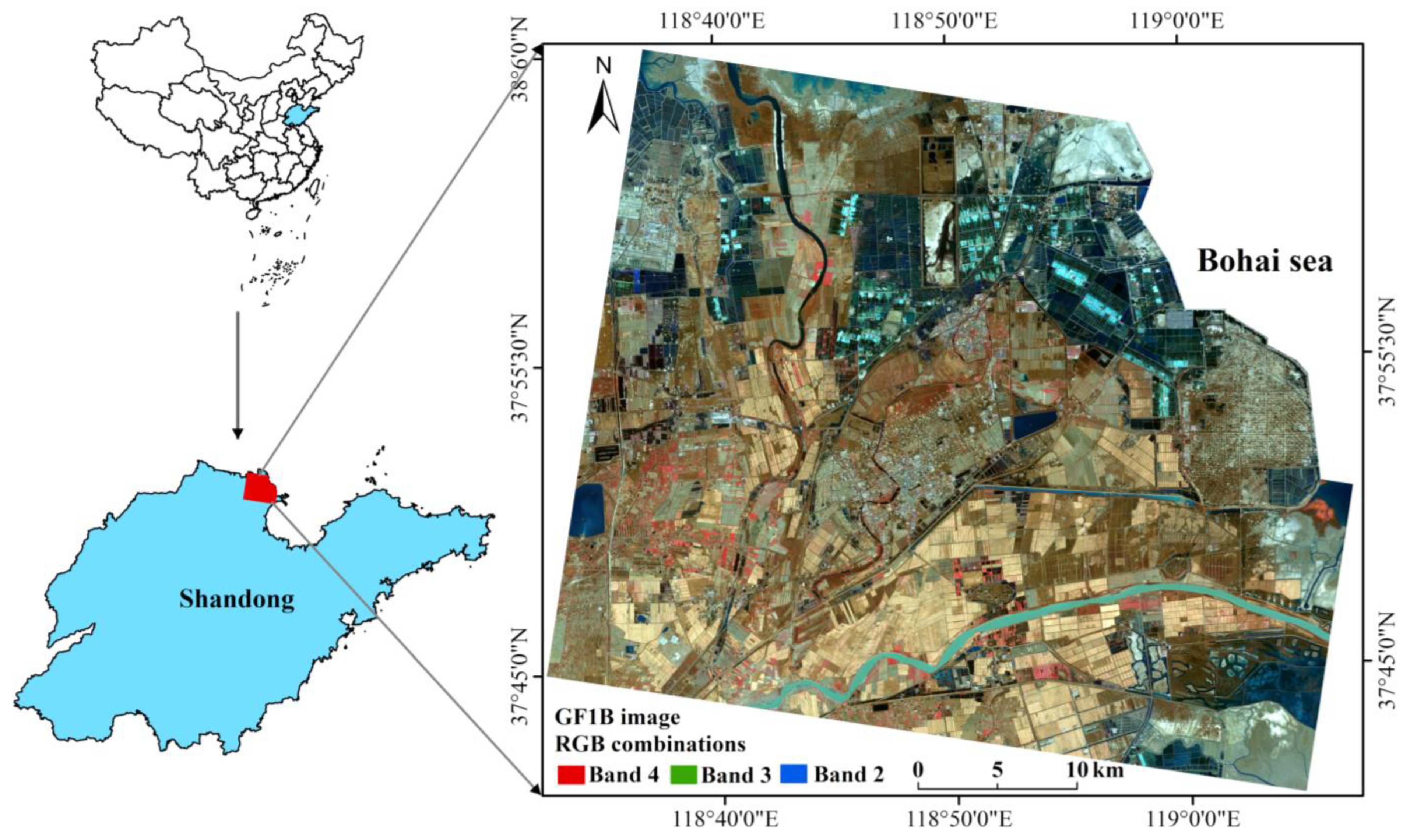


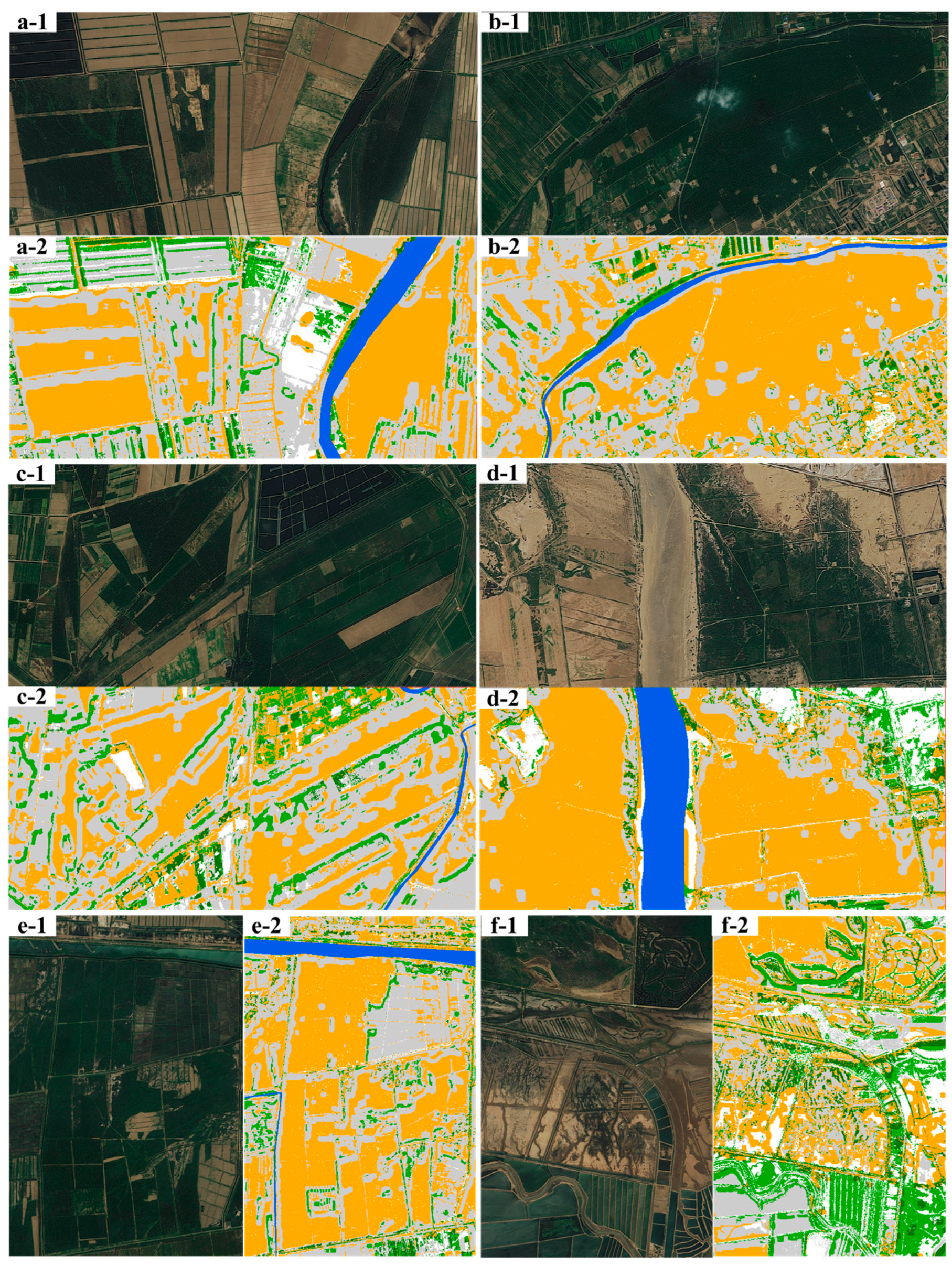

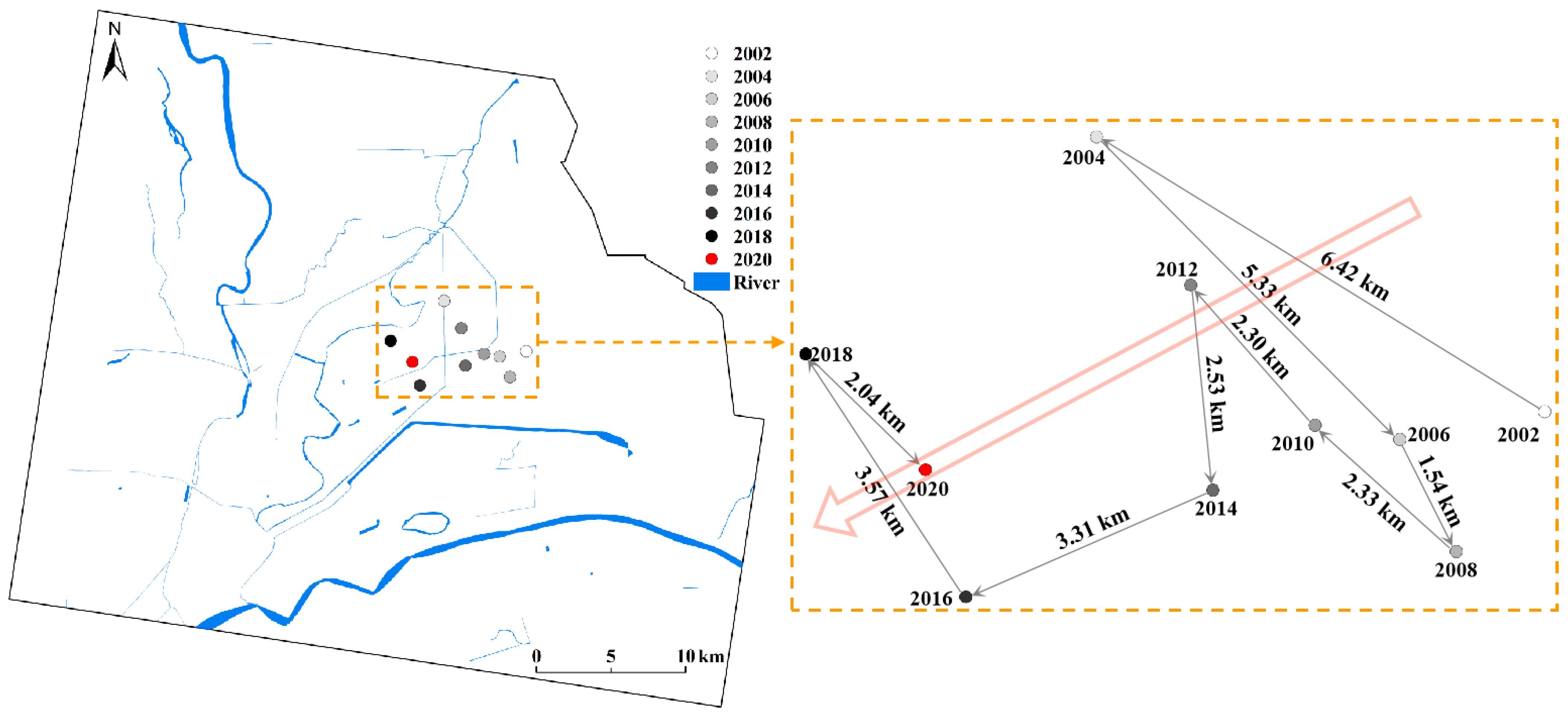
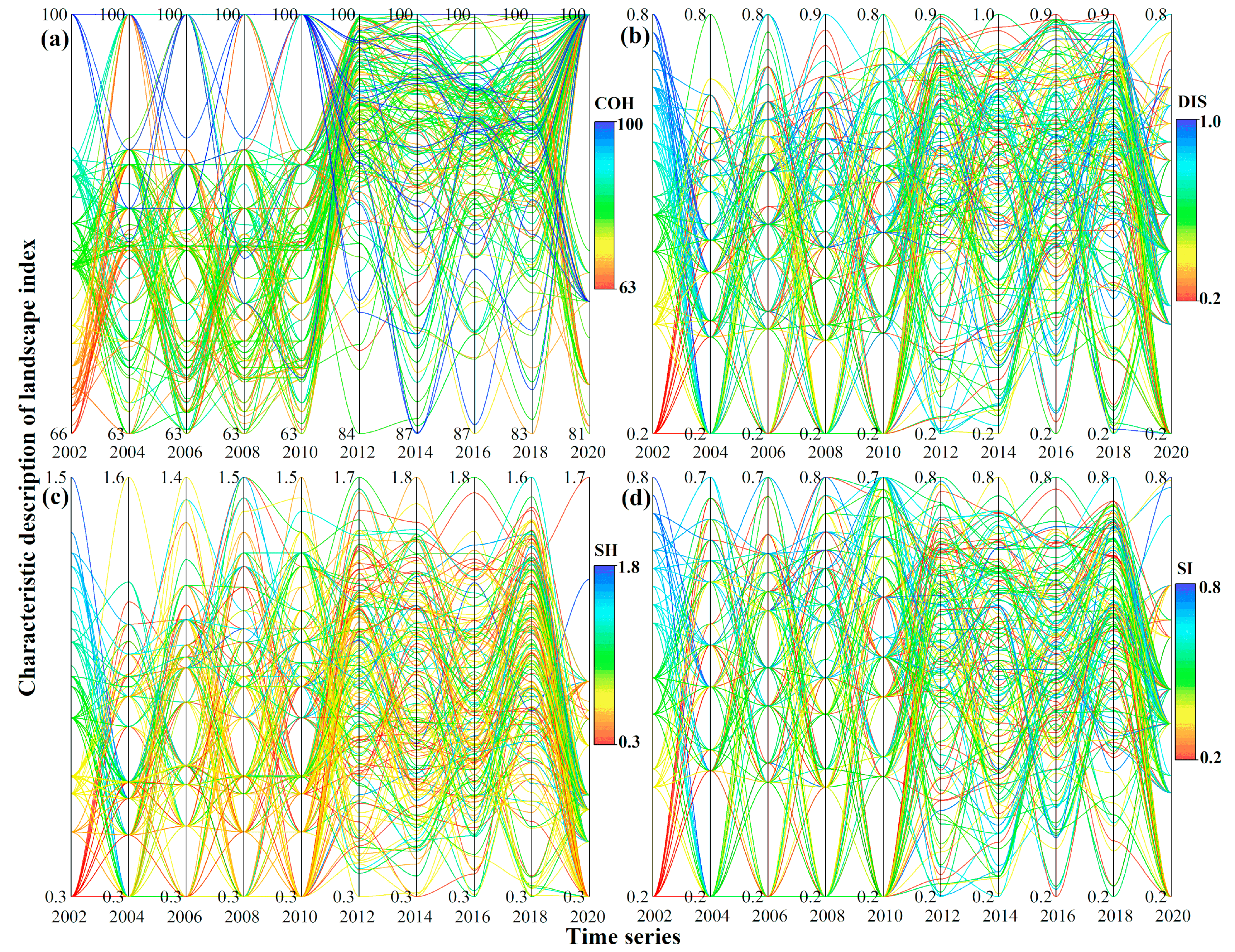

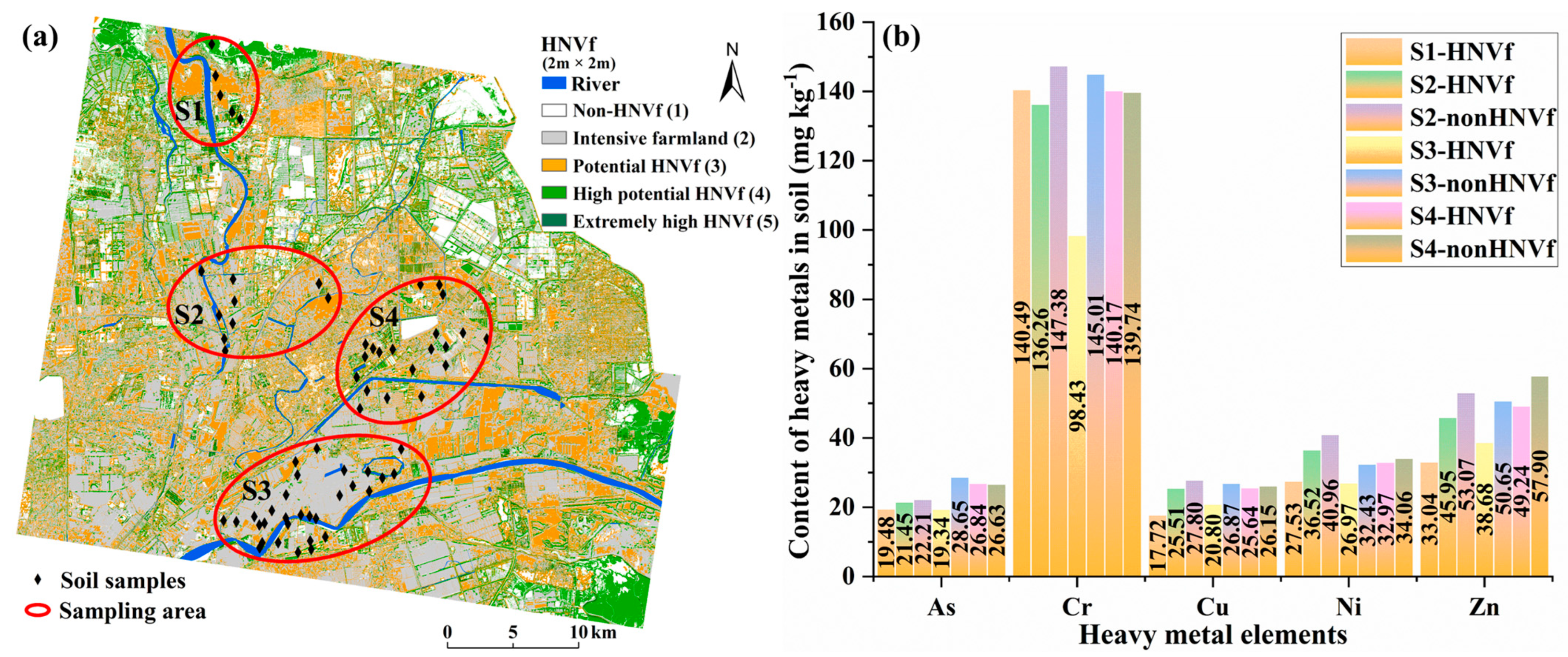
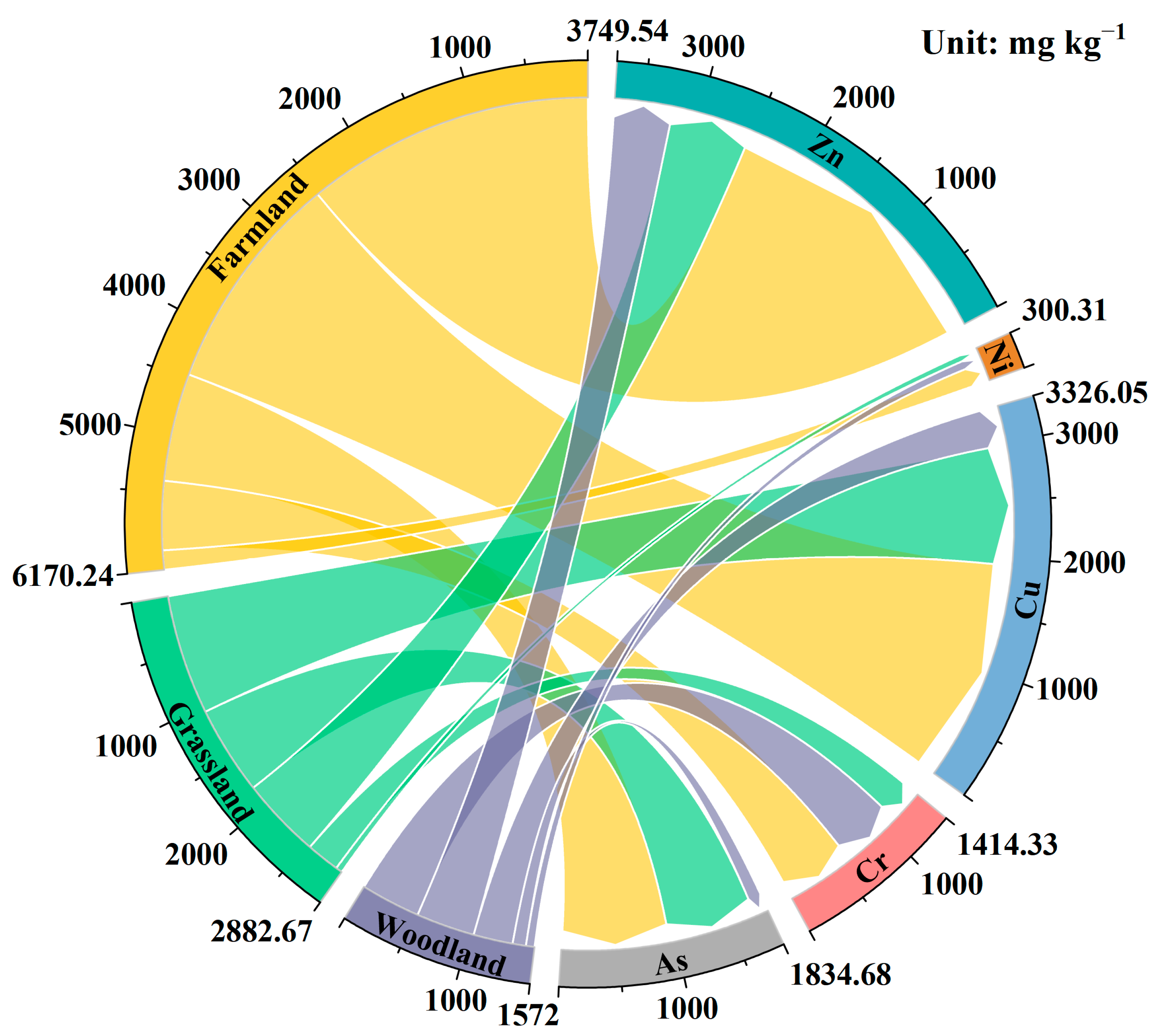
| Sensor | Time | Accuracy | Sensor | Time | Accuracy |
|---|---|---|---|---|---|
| ETM+ | 15 October 2002 | 90.69% | ETM+ | 27 November 2012 | 93.52% |
| ETM+ | 21 November 2004 | 90.10% | OLI | 9 November 2014 | 94.56% |
| ETM+ | 11 November 2006 | 91.15% | OLI | 30 November 2016 | 94.88% |
| ETM+ | 18 December 2008 | 92.40% | OLI | 20 November 2018 | 93.25% |
| ETM+ | 8 December 2010 | 91.51% | OLI | 10 November 2020 | 94.77% |
Disclaimer/Publisher’s Note: The statements, opinions and data contained in all publications are solely those of the individual author(s) and contributor(s) and not of MDPI and/or the editor(s). MDPI and/or the editor(s) disclaim responsibility for any injury to people or property resulting from any ideas, methods, instructions or products referred to in the content. |
© 2023 by the authors. Licensee MDPI, Basel, Switzerland. This article is an open access article distributed under the terms and conditions of the Creative Commons Attribution (CC BY) license (https://creativecommons.org/licenses/by/4.0/).
Share and Cite
Song, Y.; Zhang, Z.; Li, Y.; Zou, R.; Wang, L.; Yang, H.; Hu, Y. The Role of High Nature Value Farmland for Landscape and Soil Pollution Assessment in a Coastal Delta in China Based on High-Resolution Indicators. Sustainability 2023, 15, 6728. https://doi.org/10.3390/su15086728
Song Y, Zhang Z, Li Y, Zou R, Wang L, Yang H, Hu Y. The Role of High Nature Value Farmland for Landscape and Soil Pollution Assessment in a Coastal Delta in China Based on High-Resolution Indicators. Sustainability. 2023; 15(8):6728. https://doi.org/10.3390/su15086728
Chicago/Turabian StyleSong, Yingqiang, Zeao Zhang, Yan Li, Runyan Zou, Lu Wang, Hao Yang, and Yueming Hu. 2023. "The Role of High Nature Value Farmland for Landscape and Soil Pollution Assessment in a Coastal Delta in China Based on High-Resolution Indicators" Sustainability 15, no. 8: 6728. https://doi.org/10.3390/su15086728






